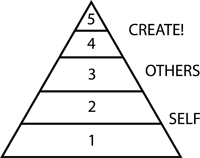Often I wonder what makes a great “product person”. There are definitely those “product manager” type attributes like project management skills, group management skills, business development experience, and the like. These are important, but I want to talk more about those fuzzy skills that give a person a sensitivity towards what makes a great product out in the marketplace.
So perhaps the “product person” I talk about is not just about the product manager or those we choose to lead product teams. I am talking about anyone who seems to have that innate sensitivity and instinct towards creating a great product.
I thought about this for a while and thought it could expressed as a hierarchy like a pyramid:

In describing the levels in numerical order, the bottom-most levels deal with the self. The next level expands thinking to include others. And the top most levels deal with actually being able to do something about it.
The levels are:
1. Can only express a like or dislike for something, but cannot articulate why, or very vaguely.
2. Can explain clearly why they like or dislike something.
3. Can explain clearly why others like or dislike something.
4. Can create something for yourself, that is expression of likes, and/or fixes dislikes.
5. Can create something for others, that is expression of likes and/or fixes dislikes.
I talk about a person’s product sensitivity as likes or dislikes in the sense for what they would like or dislike in product. In this case, a great product is a product that many people likes a lot about, and dislikes very little about it. So in other words, a great product is one we love, want, or even need. My definition of a great product person is someone who has risen to the top of the pyramid and not only express likes or dislikes for himself and for others, but one that can take those likes and dislikes and create something that not only he loves, but everyone else does too.
The pyramid is an illustration of how rare great product people are. A lot more people inhabit the lower portions of the pyramid and pretty much everyone can tell you whether they like or hate something. But they can’t necessarily explain why.
Then as you move up the pyramid, you also need to be able to release your own ego and expand your sensitivity to others. This is very difficult as most people are very self-centered and tend to like solving problems for themselves. In fact, it’s a lot easier to solve problems for yourself since you know yourself pretty well and can keep at it until you like something a lot, and your dislikes disappear. However, doing this for other people is much much harder.
In design, we are taught design processes which tease out what others like and dislike and we have methodologies to discover them, and to figure out what to do about them. These processes can help create great products, even though the people involved may not be superior product people.
But, I believe the best product people have an instinctive connection to what makes a great product and often does not require additional processes and methodologies to do so. These processes and methodologies certainly enhance a great product person’s ability to create something great, so many great product people smartly employ these techniques to fine tune their creations.
I offer up this hierarchical pyramid of product people attributes as a potential way of evaluating whether or not someone truly is a great product person or not. I think that it could be a way to structure questions to ask a potential hire by giving them an example of a product to evaluate, and see how far up the pyramid they get in terms of sensitivities. Then you can figure out whether or not the person is great enough a product person for you to hire.
The Hierarchy of Attributes for a Product Person
1 Reply